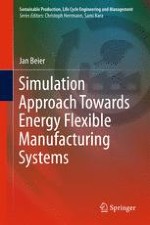2017 | OriginalPaper | Chapter
3. Existing Approaches in the Field of Energy Flexible Manufacturing Systems
Author : Jan Beier
Published in: Simulation Approach Towards Energy Flexible Manufacturing Systems
Publisher: Springer International Publishing
Activate our intelligent search to find suitable subject content or patents.
Select sections of text to find matching patents with Artificial Intelligence. powered by
Select sections of text to find additional relevant content using AI-assisted search. powered by
